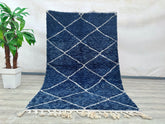What Makes a Handmade Moroccan Rug Special?
Moroccan Kilim Pillows and Berber Carpets: An Emblem of Tradition and Style in Home Decor
In today’s world of interior design, embracing multicultural themes has gained immense popularity. To truly elevate your home decor, incorporating unique, culturally rich accessories is essential. Moroccan Kilim pillows and Berber carpets are stunning additions that not only add comfort but also narrate a story of Moroccan heritage and artistry. Retailers worldwide now feature collections that reflect specific cultures, with Moroccan decor standing out as one of the most sought-after styles. Handwoven Moroccan rugs and vibrant Kilim pillows bring warmth and sophistication to any space, creating a cozy and inviting atmosphere in your home.
The Allure of Moroccan Berber Carpets
Moroccan Berber carpets are treasured globally among art lovers and interior decorators for their unique character and historical depth. Skilled weavers from Berber tribes in the Atlas Mountains hand-knot each rug, passing down techniques and designs from generation to generation. These distinctive carpets reflect the traditions, colors, and stories of each tribe, making them not only a decorative addition but also a piece of cultural history.
The Origins of Berber Rugs
Moroccan Berber rugs originated in the Berber tribes settled in the Middle and High Atlas Mountains. Despite the Arab conquest, these tribes retained their presence and distinct weaving traditions. Known for their characteristic designs and functional versatility, each Berber rug carries unique patterns and colors, representing the family or tribe that created it. For centuries, these rugs have been crafted by hand, making each piece a symbol of cultural endurance. Today, Berber rugs are still woven by families across Morocco, preserving the traditional methods and significance of these timeless pieces.
Reflection of Berber Tribes in Moroccan Rugs
The style and symbolism in Moroccan Berber carpets vary depending on the tribe. The most well-known types are the Beni Ourain rugs from the Beni Ourain tribes, the Glaoua carpets of the High Atlas, and the Achdif carpets crafted by the Zayane and Zemmour tribes in the Middle Atlas. These diverse styles are highly prized in interiors worldwide and add a unique Moroccan flair to any room.
Intricate Moroccan Rug Designs
Morocco is known for the countless carpet designs produced across its regions and tribes. Each community uses distinct methods, infusing rugs with individual aesthetics. Three primary weaving techniques are typically used:
-
Pile or Knotted Carpets: These have a plush, textured surface created by tying short yarn pieces around the warp threads.
-
Flat Weave: This approach weaves yarn horizontally, producing a smooth, even surface.
-
Embroidered Layering: This technique adds intricate patterns and motifs on a flat weave surface.
Moroccan rugs are known for their striking designs and vibrant colors. For a minimalist look, choose a rug with a subtle pattern to balance visually intense spaces. The casual and cozy appeal of these rugs captures the essence of Morocco’s tribal culture and blends beautifully with both traditional and modern interiors.
High-Quality Natural Materials
Moroccan rugs are crafted from natural materials, typically wool or cotton, providing a luxurious texture that synthetic fibers cannot match. The rich, soft feel of these rugs is enhanced by high-quality wool sourced from the Atlas Mountains. One distinctive type, the Boucharouite, uses recycled fabric scraps like cotton, nylon, and synthetic fibers, making it an eco-friendly and unique option.
Vibrant Moroccan Carpet Colors
One defining trait of Moroccan Berber carpets is their vibrant colors, which vary based on the tribe and the weaver’s personal inspiration. Many Berber tribes use colors and patterns that express abstract ideas, adding depth and meaning to their creations. From traditional black and white to vibrant multicolored options, Berber carpets come in shades like red, blue, green, and yellow, with each color adding unique visual appeal.
The spontaneous, communal nature of Berber weaving allows each rug to reflect the environment and values of the tribe that made it. Some tribal rugs have minimalist designs, while others, such as the Azilal rugs from the High Atlas Mountains, use vivid colors and patterns to convey stories and cultural symbols.
Moroccan Rugs in Modern Interior Decor
With their timeless appeal, Moroccan Berber carpets and Kilim pillows have become popular in modern home decor. These pieces blend effortlessly with various decor styles, adding warmth, cultural richness, and sophistication to any room. Moroccan rugs and pillows bring bohemian charm, and by layering rugs and mixing Kilim pillow patterns, you can create a visually engaging, welcoming space.
Incorporating Moroccan Kilim pillows and Berber carpets into your home not only enhances its aesthetic appeal but also pays homage to the skilled artisans and rich cultural heritage of Morocco .
Featured Products
169 x 251 cm = 5.5 x 8.2 ft moroccan wool rug, moroccan style rug, bohemian rug, handmade rug, outdoor patio, beniourain Rug, decor rug, Handmade Gift
- $599.00
$1,830.00- $599.00
- (-67%)
- Unit price
- / per
155 x 247 cm = 5.1 x 8.1 ft Diamonds Blue Soft Dots Berber Runner Rug - Handmade Moroccan Wool, Minimalist Design, Vintage Style, Perfect for Weddings & Bohemian Decor
- $599.00
$1,830.00- $599.00
- (-67%)
- Unit price
- / per










